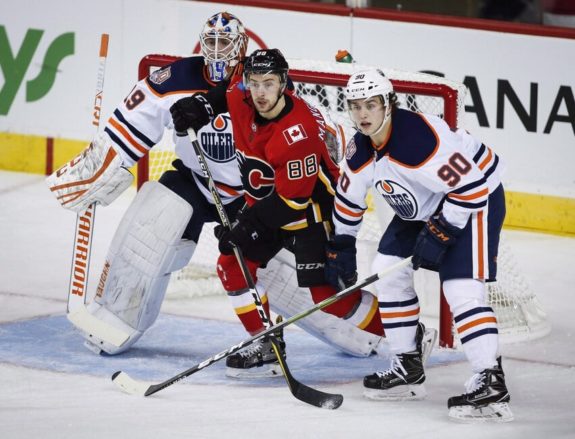“Five-by-five” is used in radio communications to indicate reception strength and clarity. A “five-by-five” signal means we can understand the transmission with perfect strength and clarity.
That is the opposite of the signal the Edmonton Oilers gave us after their 2019-20 Qualifying Round playoff loss to the Chicago Blackhawks. Judging the Oilers’ success and competitiveness based on that five-game sample size after a five-month layoff is devoid of both clarity and strength. It is neither “strong” nor “clear.”
Related: Oilers Overcome by Blackhawks Veterans in Series Loss
To refresh our memory, the Oilers won one exhibition game against the Calgary Flames in the NHL’s Return to Play before losing their series to the Blackhawks 3-1. That’s “five” games after a “five” month layoff between the end of the NHL season and the start of the playoffs. Then the knives came out.
But were the Oilers really a bad team last season?
A Better Way to Judge
A much better way to judge the state of the Oilers is to look at their complete season and assess them against one of their closest comparables in the regular season, the Dallas Stars. The Stars, after all, made it to the Stanley Cup Final, losing to the Tampa Bay Lightning.
When NHL games were suspended as of March 11, the Oilers were in second place in the Pacific Division and the Stars were in third in the Central. The Oilers had a 37-25-9 record in 71 games for a .585 winning percentage, while Dallas’ record was 37-24-8 in 69 games for a .594%. The difference is hardly enough to fit a layer of hockey tape through. Both were good, if not great, teams that were well in a playoff spot. No wild-card needed.
The only five-game streak the Oilers had in the 2019-20 regular season was a five-game winning run to start the season. They had only one four-game streak, a losing one, in December. The rest of the season is dotted with short runs of wins and losses. In the last five games of the season, they went 2-3. The Oilers were not streaky in 2019-20; they were a consistent mid-level team.
Their record indicates that they were neither near the top nor bottom of the league, but somewhere in the mushy middle, and leaning towards the higher end.
Many Good Teams Struggled to Ramp it Up After the Long Layoff
Other good teams had bad playoff runs after the five-month layoff, including the Washington Capitals, Pittsburgh Penguins, St. Louis Blues, Toronto Maple Leafs, and Winnipeg Jets here.
| TEAM | “WARM-UP” GAMES | QUALIFYING ROUND | ROUND ONE |
| Capitals | 1-2 vs Lightning, Philadelphia Flyers and Boston Bruins | 1-4 vs NY Islanders | |
| Penguins | 0-1 vs. Flyers | 1-3 vs Montreal Canadiens | |
| Blues | 0-3 vs Colorado Avalanche, Vegas Golden Knights, Stars | 2-4 vs Vancouver Canucks | |
| Maple Leafs | 1-0 vs Canadiens | 2-3 vs Columbus Blue Jackets | |
| Jets | 1-0 vs Canucks | 1-3 vs Calgary Flames |
Should these be considered “bad” teams because they couldn’t flip a switch immediately after a five-month layoff? Would you judge a business’ overall success based on one bad month, a student’s success based on a single quiz?
The Playoff Rules Suddenly Change
The NHL came up with a Return to Play Plan for the 2020 Playoffs: 24 teams were included based on points percentage and seeding was determined by conference, not division standings. Only the top four teams in each division automatically made the playoffs without having to go through a “qualifying round.”
| TEAM | SEEDING | PERCENTAGE |
| Boston Bruins | 1 | .714 |
| Tampa Bay Lighting | 2 | .657 |
| Washington Capitals | 3 | .652 |
| Philadelphia Flyers | 4 | .645 |
| Pittsburgh Penguins | 5 | .623 |
| Carolina Hurricanes | 6 | .596 |
| NY Islanders | 7 | .588 |
| Toronto Maple Leafs | 8 | .579 |
| Columbus Blue Jackets | 9 | .579 |
| Florida Panthers | 10 | .565 |
| New York Rangers | 11 | .564 |
| Montreal Canadiens | 12 | .500 |
| TEAM | SEEDING | PERCENTAGE |
| St. Louis Blues | 1 | .662 |
| Colorado Avalanche | 2 | .657 |
| Las Vegas Golden Knights | 3 | .606 |
| Dallas Stars | 4 | .594 |
| Edmonton Oilers | 5 | .585 |
| Nashville Predators | 6 | .565 |
| Vancouver Canucks | 7 | .565 |
| Calgary Flames | 8 | .564 |
| Winnipeg Jets | 9 | .563 |
| Minnesota Wild | 10 | .558 |
| Arizona Coyotes | 11 | .529 |
| Chicago Blackhawks | 12 | .514 |
With almost identical records, the Stars made the playoffs, but the Oilers would have to win a qualifying round first. Had the Oilers won their final regular-season game against the Jets on March 11, they would have had a better winning percentage than the Stars.
What no one could have known was how important it was to win that last regular-season game before the hiatus, and the impact it would have on the playoffs down the line five months later.
At the end of the second period, the game was tied 2-2. The Oilers lost the game 4-2, knowing neither that it would be their final game of the regular season nor how the final 20 minutes of the game would define their playoff trajectory. The Oilers were in the game until a late Jets’ empty net goal.
Had they won, the Oilers wouldn’t have had to play in the playoff qualifying round, buying more time to get their game together after the long layoff by (1) playing more exhibition games and (2) advancing to the playoffs directly, playing best-of-seven series instead of best-of-five. Longer series, of course, make it possible to recover from poor starts.

The Oilers got just five games to try and work their five months of rust out. They never managed to do that in the short window given to them. The team played poorly, were eliminated and will have to listen to the catcalls for extensive team change for another five months, or more, depending on when the new season starts.
Stars Had Longer Losing Streaks Through the Season
Yes, the Stars’ playoff success makes their season much more successful than the Oilers. However, that doesn’t necessarily mean they were a better team last season or will be a better one next. Nor should general manager Ken Holland judge his team based on a single stretch of five games after a lengthy pause.
The Stars had a few five-game slumps last season. They started 2019-20 with a 1-7-1 record and a five-game losing streak. They also ended the season on a six-game losing streak. After their five-month layoff, they went 1-2 in their playoff warm-up games against the Golden Knights, Avalanche and Blues.
They then lost two of their first three playoff games against the Flames before coming back to win the series and continue into the playoffs. Those extra games gave them time to get their feet back under them after a five-month layoff. The Oilers had no such luxury. They had one warm-up game before the knock-out series. Edmonton played badly and they were out. Meanwhile, the Stars played badly, were given time to recuperate, and almost won the Stanley Cup.
No Panic in Holland’s Game
After the Oilers were eliminated, the Edmonton media and fans went into full panic mode: The team was wasting their Connor McDavid and Leon Draisaitl years; McDavid would demand a trade; the team had to go full Peter Chiarelli and make bad, hasty knee-jerk decisions. Fortunately, team management stayed the course and listened to none of the above.

Instead, while admitting that the team had underperformed against the Blackhawks, they stepped up to let the team’s fans know that despite the disappointing loss, it was not deemed representative of the Oilers’ overall play. President Bob Nicholson told Bob Stauffer on an Oilers Now radio broadcast:
“We just weren’t good enough. When I look back at it I thought Kenny Holland did a really good job, really improved this team, didn’t have much to work with, brought in a lot of players that made us better, but the bottom line is we lost to Chicago and we have to do better than that … We’re not going to make huge changes but Ken will tinker with this line-up,”
(from ‘No huge moves for Edmonton Oilers in offseason, just tinkering with the team, says team exec,’ Edmonton Journal, 09/19/2020).
Steady as She Goes
“Tinkering” was all Holland was promising, even after the devastating elimination. The day after the playoffs, he told Stauffer, “We’ve got some good pros back there … I want to make sure that we’re all not just reacting to a four-game series in the middle of August.”
He continued to say in the same Edmonton Journal article:
“This is my philosophy. I don’t know if it’s right or it’s wrong, but you’ve got to have a philosophy. My philosophy is on continuity and patience. But you’ve got to have change. You need change to make the team better. We wheeled a lot of bodies in here but you can’t just year wheel six and seven and eight bodies out, wheel in six and seven and eight bodies, and the next summer wheel out six and seven, and wheel in, and think that you’re going to build anything,”
The Oilers’ 2019-20 season, outside of their early winning streak, was a series of dribs and drabs, of win-loss-loss-win-win. They neither dominated nor were consistently poor, middle tier team trending upwards. One five-game stretch after a five-month layoff can’t change that.
Holland is smart enough to see it. Yet, somehow, because the Stars made the Stanley Cup Final, they are considered a much better team than the Oilers going into the 2020-21 season.
Were the 2019-20 Oilers a bad team? A team ranked 12th in winning percentage? A team with McDavid and Draisaitl, the top-two point leaders in the league? A team with a league-leading 29.5% power play percentage? A team ranked 2nd in penalty-killing at 84%?

A bad team? I think not. There was neither strength nor clarity in the message the Oilers qualifying round performance showed. Certainly not enough “clarity” nor “strength” to override the message sent by the entirety of their year’s performance.